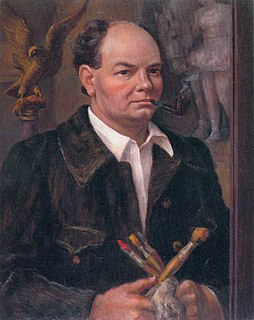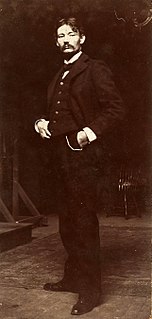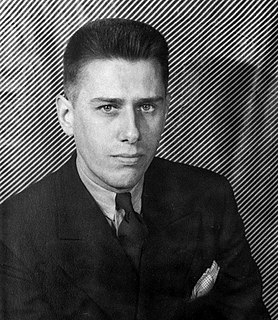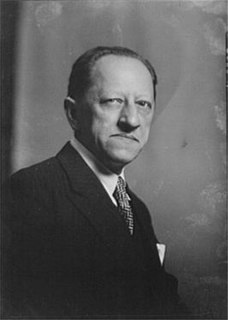Oscar Edmund Berninghaus was an American artist and a founding member of the Taos Society of Artists. He is best known for his paintings of Native Americans, New Mexico and the American Southwest. His son, Charles Berninghaus (1905–1988), was also a Taos artist.

John Constable was an English landscape painter in the Romantic tradition. Born in Suffolk, he is known principally for revolutionising the genre of landscape painting with his pictures of Dedham Vale, the area surrounding his home – now known as "Constable Country" – which he invested with an intensity of affection. "I should paint my own places best", he wrote to his friend John Fisher in 1821, "painting is but another word for feeling".
Blackbear Bosin was a self-taught Comanche/Kiowa sculptor, painter, and commercial artist. He is also known by his Kiowa name, Tsate Kongia, which means "black bear."

John Steuart Curry was an American painter whose career spanned the years from 1924 until his death. He was noted for his paintings depicting rural life in his home state, Kansas. Along with Thomas Hart Benton and Grant Wood, he was hailed as one of the three great painters of American Regionalism of the first half of the twentieth century. Curry's artistic production was varied, including paintings, book illustrations, prints, and posters.

George Benjamin Luks was an American artist, identified with the aggressively realistic Ashcan School of American painting.

The Ashcan School, also called the Ash Can School, was an artistic movement in the United States during the late 19th-early 20th century that is best known for works portraying scenes of daily life in New York, often in the city's poorer neighborhoods.

Georges de La Tour was a French Baroque painter, who spent most of his working life in the Duchy of Lorraine, which was temporarily absorbed into France between 1641 and 1648. He painted mostly religious chiaroscuro scenes lit by candlelight.

Jerome Myers was an American artist and writer associated with the Ashcan School, particularly known for his sympathetic depictions of the urban landscape and its people. He was one of the main organizers of the 1913 Armory Show, which introduced European modernism to America.

Robert Henri was an American painter and teacher.

Paul Cadmus was an American artist widely known for his egg tempera paintings of gritty social interactions in urban settings. He also produced many highly finished drawings of single nude male figures. His paintings combine elements of eroticism and social critique in a style often called magic realism.
Daniel E. Greene PSA, NA, AWS was an American artist who worked in the media of pastels and oil painting. The Encyclopædia Britannica considered Mr. Greene the foremost pastelist in the United States. His paintings and pastels are in over 700 public and private collections in the United States and abroad. Highly regarded as a portrait artist, his subjects have included leaders of Government, Banking, Education and Industry. Some of his sitters include First Lady Eleanor Roosevelt, Ayn Rand, Astronaut Walter Schirra, William Randolph Hearst, “Wendy’s” founder Dave Thomas, Commentator Rush Limbaugh, Composer Alan Menken, Bryant Gumbel and Bob Schieffer of CBS TV. Governmental Portraits include Secretary of Agriculture Ann Veneman, Governor Paul Laxalt of Nevada, Governor Gerald Baliles of Virginia, Governor Benjamin Cayetano of Hawaii, and Governor Fob James of Alabama. Business sitters include the chairmen of the boards of Honeywell, Coca-Cola Company, Dupont Corporation, Endo Pharmaceuticals, American Express, The New York Stock Exchange and IBM. Mr. Greene has also painted the Deans, Presidents and Benefactors of Hobart & William Smith Colleges, Tufts, Duke, Columbia, North Carolina, West Point, Delaware, Penn State, New York, Princeton, Rutgers, Yale and Harvard Universities.

William James Glackens was an American realist painter and one of the founders of the Ashcan School, which rejected the formal boundaries of artistic beauty laid-down by the conservative National Academy of Design. He is also known for his work in helping Albert C. Barnes to acquire the European paintings that form the nucleus of the famed Barnes Foundation in Philadelphia. His dark-hued, vibrantly painted street scenes and depictions of daily life in pre-WW I New York and Paris first established his reputation as a major artist. His later work was brighter in tone and showed the strong influence of Renoir. During much of his career as a painter, Glackens also worked as an illustrator for newspapers and magazines in Philadelphia and New York City.

Alfred Henry Maurer was an American modernist painter. He exhibited his work in avant-garde circles internationally and in New York City during the early twentieth century. Highly respected today, his work met with little critical or commercial success in his lifetime, and he died, a suicide, at the age of sixty-four.
Spurgeon Tucker was an accomplished 20th-century American painter and successful lithographer. He was primarily known for his portraits of Hollywood celebrities, but many would contend that his finest works were of the things he loved most: his family, everyday items from his Long Island home and quiet countryside scenes.

Leon Kroll was an American painter and lithographer. A figurative artist described by Life magazine as "the dean of U.S. nude painters", he was also a landscape painter and also produced an exceptional body of still life compositions. His public art includes murals for the Department of Justice Building in Washington, D.C. He created his only mosaic for the chapel ceiling at Normandy American Cemetery and Memorial.

Henry Fitch Taylor (1853–1925) was an American painter who was to become the oldest among the generation of American artists who responded to and explored Cubism. Taylor served as the first president of the American Association of Artists and Painters (AAPS), the organization which mounted the 1913 Armory Show; he later stepped aside from that role in favor of Arthur B. Davies, but continued to serve as trustee and secretary of AAPS.

Mae Ethel Klinck Myers, better known as Ethel Myers, was a New York Realist artist and sculptor strongly influenced in her work by the goals of the Ashcan School and its leader and famous teacher, Robert Henri. Her earliest subjects for pictures involved her capturing the life of the Lower East Side as well as journeying to slums in other cities such as Boston. Her greatest fame came some years later, after her marriage to New York artist Jerome Myers, when she became known for her figurative bronze statuettes and figurines "with a quite uncommon sense of humor, and with more than this, a feeling for form and movement that gives them life and conviction." "Her three powerfully expressed sculptured figurines impress this reviewer with the fact that she is worthy of a place alongside of Daumier, Meunier and Mahonri Young."

In 1842, British artist J. M. W. Turner painted three watercolours of the Rigi, a mountain in the Alps in Central Switzerland, which he had visited the previous summer. Widely regarded as some of his finest works, the watercolours capture the transitory effects of light and atmospheric conditions at the Rigi. According to John Ruskin, "Turner had never made any drawings [watercolours] like these before, and never made any like them again ... He is not showing his hand in these, but his heart."

Titus Kaphar is an American contemporary painter whose work reconfigures and regenerates art history to include the African-American subject. His paintings are held in the collections of Museum of Modern Art, Brooklyn Museum, Yale University Art Gallery, New Britain Museum of American Art, Seattle Art Museum, Virginia Museum of Fine Arts, and University of Michigan Museum of Art.
Malcolm Haynie Myers was an American painter, printmaker and professor known primarily for his Intaglio-style engravings. His work is included in numerous museum collections.















